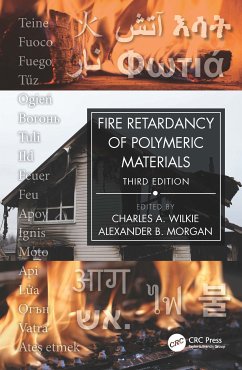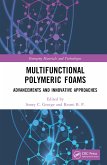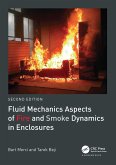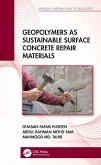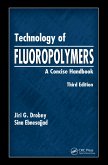Fire Retardancy of Polymeric Materials
Herausgeber: Morgan, Alexander B.; Wilkie, Charles A.
Fire Retardancy of Polymeric Materials
Herausgeber: Morgan, Alexander B.; Wilkie, Charles A.
- Gebundenes Buch
- Merkliste
- Auf die Merkliste
- Bewerten Bewerten
- Teilen
- Produkt teilen
- Produkterinnerung
- Produkterinnerung
The third edition of Fire Retardancy of Polymeric Materials provides a single source for all aspects of this highly challenging field of applied research. This authoritative book covers design and non-fire requirements that drive how these materials are fire protected.
Andere Kunden interessierten sich auch für
![Multifunctional Polymeric Foams Multifunctional Polymeric Foams]() Multifunctional Polymeric Foams167,99 €
Multifunctional Polymeric Foams167,99 €![Fluid Mechanics Aspects of Fire and Smoke Dynamics in Enclosures Fluid Mechanics Aspects of Fire and Smoke Dynamics in Enclosures]() Bart Merci (Belgium Ghent University)Fluid Mechanics Aspects of Fire and Smoke Dynamics in Enclosures93,99 €
Bart Merci (Belgium Ghent University)Fluid Mechanics Aspects of Fire and Smoke Dynamics in Enclosures93,99 €![Solar Textiles Solar Textiles]() Robert MatherSolar Textiles103,99 €
Robert MatherSolar Textiles103,99 €![Geopolymers as Sustainable Surface Concrete Repair Materials Geopolymers as Sustainable Surface Concrete Repair Materials]() Ghasan Fahim HuseienGeopolymers as Sustainable Surface Concrete Repair Materials156,99 €
Ghasan Fahim HuseienGeopolymers as Sustainable Surface Concrete Repair Materials156,99 €![Multiplicative Analytic Geometry Multiplicative Analytic Geometry]() Svetlin G. GeorgievMultiplicative Analytic Geometry115,99 €
Svetlin G. GeorgievMultiplicative Analytic Geometry115,99 €![Technology of Fluoropolymers Technology of Fluoropolymers]() Jiri G. Drobny (USA Drobny Polymer Associates)Technology of Fluoropolymers139,99 €
Jiri G. Drobny (USA Drobny Polymer Associates)Technology of Fluoropolymers139,99 €![Enclosure Fire Dynamics, Second Edition Enclosure Fire Dynamics, Second Edition]() Bjorn KarlssonEnclosure Fire Dynamics, Second Edition178,99 €
Bjorn KarlssonEnclosure Fire Dynamics, Second Edition178,99 €-
-
-
The third edition of Fire Retardancy of Polymeric Materials provides a single source for all aspects of this highly challenging field of applied research. This authoritative book covers design and non-fire requirements that drive how these materials are fire protected.
Hinweis: Dieser Artikel kann nur an eine deutsche Lieferadresse ausgeliefert werden.
Hinweis: Dieser Artikel kann nur an eine deutsche Lieferadresse ausgeliefert werden.
Produktdetails
- Produktdetails
- Verlag: Taylor & Francis Ltd
- 3 ed
- Seitenzahl: 776
- Erscheinungstermin: 29. Juli 2024
- Englisch
- Abmessung: 283mm x 212mm x 45mm
- Gewicht: 2304g
- ISBN-13: 9781032457543
- ISBN-10: 1032457546
- Artikelnr.: 70288028
- Herstellerkennzeichnung
- Libri GmbH
- Europaallee 1
- 36244 Bad Hersfeld
- 06621 890
- Verlag: Taylor & Francis Ltd
- 3 ed
- Seitenzahl: 776
- Erscheinungstermin: 29. Juli 2024
- Englisch
- Abmessung: 283mm x 212mm x 45mm
- Gewicht: 2304g
- ISBN-13: 9781032457543
- ISBN-10: 1032457546
- Artikelnr.: 70288028
- Herstellerkennzeichnung
- Libri GmbH
- Europaallee 1
- 36244 Bad Hersfeld
- 06621 890
Alexander B. Morgan received his B.S in Chemistry from Virginia Military Institute in 1994 and his Ph.D. in Chemistry from the University of South Carolina in 1998. Dr. Morgan has over twenty-seven years of experience in the areas of materials flammability, polymeric material flame retardancy, fire science, fire testing, thermal decomposition chemistry, and fire safety engineering with an emphasis on chemical structure property relationships and fire safe material design. He has helped academic, government, and industrial customers solve their flame retardant and fire safety needs in a wide range of applications. Dr. Morgan is on the editorial review board for Fire and Materials, and is the Editor-in-Chief for the Journal of Fire Science. He is also a member of ASTM, Sigma Xi, the International Association of Fire Safety Scientists, and the American Chemical Society. His current research areas include: * New Flame Retardant Technology with Reduced Environmental Impact for Electronics, Building Materials, Bedding/Furniture, Wire & Cable, Transportation, Textiles. * Fire Testing Method Development * Fire Safety / Survivability for Aircraft and Ground Vehicles * Materials Development, and Technology Assessment for Additive Manufacturing for Aerospace Applications Charles A. Wilkie received his BS degree in Chemistry from the University of Detroit in 1963 and his Ph.D. in Inorganic Chemistry from Wayne State University in 1967. He subsequently joined Marquette University as an Assistant Professor and rose through the ranks until retiring in 2009; he now is Professor Emeritus. In 1978, he read a paper on phosphorus-based flame retardants and decided to move into that area. He has worked in the field of flame retardancy for more than 30 years. His initial work was to attempt to understand mechanistically how a flame retardant interacts with a polymer. His research group also did quite a bit of work on nano-composite based flame retardancy. Wilkie has served, and continues to serve, on the editorial boards of several journals and has been involved with organizing several meetings in this area.
1. An Introduction to Materials Flame Retardancy and Fire Protection. 2.
Thermal Decomposition of Flame Retardant Polymers. 3. Physical Parameters
Affecting Fire Growth. 4. Halogen Containing Flame retardants. 5.
Phosphorus-Containing Flame Retardants. 6. Flame Retardant Fillers. 7.
Intumescence-based flame retardants. 8. Silicon and Inorganic Flame
Retardants. 9. Boron-Based Flame Retardants. 10. Nitrogen-Based Flame
Retardants. 11. Non halogen radical generators for enhanced flame
retardancy of plastics. 12. Polymer Nanocomposites. 13. Bio-based flame
retardants. 14. Conformal Flame Retardant Coating Systems. 15. Flame
Retardants without Conventional Flame-Retardant Elements. 16.
Multi-component Flame Retardant Systems. 17. Uses of Fire Tests for
Flame-Retardant Material Development. 18. Material Flammability
Measurements and Test Methods. 19. Fire Emissions and Smoke Toxicity. 20.
Toward a Quantitative Relation between the Molecular Structure and Fire
Growth on Polymeric Solids. 21. Full-Scale Fire Modeling and Simulation.
22. Regulations, codes, and standards relevant to fire issues in the United
States. 23. Chemical Regulation of Flame Retardants. 24. Recycling of Flame
Retardant Polymeric Materials: State of the Art and Future Perspectives.
25. Flame Retardant Design and Protection for Fiber-Reinforced Composites.
26. Flame Retardant Design and Protection for Wood and Wood Products. 27.
Flame Retardant Design and Protection for Textiles. 28. Flame Retardant
Design and Protection for Electrical and Electronic Systems. 29. Flame
Retardant Design and Protection for Wire and Cable. 30. Flame Retardant
Design and Protection for Building Materials. 31. Flame Retardant Design
and Protection for Furniture and Furnishings. 32. The Future of Material
Fire Protection - Unmet Needs, New Fire Risk Scenarios, and New Flame
Retardant Approaches.
Thermal Decomposition of Flame Retardant Polymers. 3. Physical Parameters
Affecting Fire Growth. 4. Halogen Containing Flame retardants. 5.
Phosphorus-Containing Flame Retardants. 6. Flame Retardant Fillers. 7.
Intumescence-based flame retardants. 8. Silicon and Inorganic Flame
Retardants. 9. Boron-Based Flame Retardants. 10. Nitrogen-Based Flame
Retardants. 11. Non halogen radical generators for enhanced flame
retardancy of plastics. 12. Polymer Nanocomposites. 13. Bio-based flame
retardants. 14. Conformal Flame Retardant Coating Systems. 15. Flame
Retardants without Conventional Flame-Retardant Elements. 16.
Multi-component Flame Retardant Systems. 17. Uses of Fire Tests for
Flame-Retardant Material Development. 18. Material Flammability
Measurements and Test Methods. 19. Fire Emissions and Smoke Toxicity. 20.
Toward a Quantitative Relation between the Molecular Structure and Fire
Growth on Polymeric Solids. 21. Full-Scale Fire Modeling and Simulation.
22. Regulations, codes, and standards relevant to fire issues in the United
States. 23. Chemical Regulation of Flame Retardants. 24. Recycling of Flame
Retardant Polymeric Materials: State of the Art and Future Perspectives.
25. Flame Retardant Design and Protection for Fiber-Reinforced Composites.
26. Flame Retardant Design and Protection for Wood and Wood Products. 27.
Flame Retardant Design and Protection for Textiles. 28. Flame Retardant
Design and Protection for Electrical and Electronic Systems. 29. Flame
Retardant Design and Protection for Wire and Cable. 30. Flame Retardant
Design and Protection for Building Materials. 31. Flame Retardant Design
and Protection for Furniture and Furnishings. 32. The Future of Material
Fire Protection - Unmet Needs, New Fire Risk Scenarios, and New Flame
Retardant Approaches.
1. An Introduction to Materials Flame Retardancy and Fire Protection. 2.
Thermal Decomposition of Flame Retardant Polymers. 3. Physical Parameters
Affecting Fire Growth. 4. Halogen Containing Flame retardants. 5.
Phosphorus-Containing Flame Retardants. 6. Flame Retardant Fillers. 7.
Intumescence-based flame retardants. 8. Silicon and Inorganic Flame
Retardants. 9. Boron-Based Flame Retardants. 10. Nitrogen-Based Flame
Retardants. 11. Non halogen radical generators for enhanced flame
retardancy of plastics. 12. Polymer Nanocomposites. 13. Bio-based flame
retardants. 14. Conformal Flame Retardant Coating Systems. 15. Flame
Retardants without Conventional Flame-Retardant Elements. 16.
Multi-component Flame Retardant Systems. 17. Uses of Fire Tests for
Flame-Retardant Material Development. 18. Material Flammability
Measurements and Test Methods. 19. Fire Emissions and Smoke Toxicity. 20.
Toward a Quantitative Relation between the Molecular Structure and Fire
Growth on Polymeric Solids. 21. Full-Scale Fire Modeling and Simulation.
22. Regulations, codes, and standards relevant to fire issues in the United
States. 23. Chemical Regulation of Flame Retardants. 24. Recycling of Flame
Retardant Polymeric Materials: State of the Art and Future Perspectives.
25. Flame Retardant Design and Protection for Fiber-Reinforced Composites.
26. Flame Retardant Design and Protection for Wood and Wood Products. 27.
Flame Retardant Design and Protection for Textiles. 28. Flame Retardant
Design and Protection for Electrical and Electronic Systems. 29. Flame
Retardant Design and Protection for Wire and Cable. 30. Flame Retardant
Design and Protection for Building Materials. 31. Flame Retardant Design
and Protection for Furniture and Furnishings. 32. The Future of Material
Fire Protection - Unmet Needs, New Fire Risk Scenarios, and New Flame
Retardant Approaches.
Thermal Decomposition of Flame Retardant Polymers. 3. Physical Parameters
Affecting Fire Growth. 4. Halogen Containing Flame retardants. 5.
Phosphorus-Containing Flame Retardants. 6. Flame Retardant Fillers. 7.
Intumescence-based flame retardants. 8. Silicon and Inorganic Flame
Retardants. 9. Boron-Based Flame Retardants. 10. Nitrogen-Based Flame
Retardants. 11. Non halogen radical generators for enhanced flame
retardancy of plastics. 12. Polymer Nanocomposites. 13. Bio-based flame
retardants. 14. Conformal Flame Retardant Coating Systems. 15. Flame
Retardants without Conventional Flame-Retardant Elements. 16.
Multi-component Flame Retardant Systems. 17. Uses of Fire Tests for
Flame-Retardant Material Development. 18. Material Flammability
Measurements and Test Methods. 19. Fire Emissions and Smoke Toxicity. 20.
Toward a Quantitative Relation between the Molecular Structure and Fire
Growth on Polymeric Solids. 21. Full-Scale Fire Modeling and Simulation.
22. Regulations, codes, and standards relevant to fire issues in the United
States. 23. Chemical Regulation of Flame Retardants. 24. Recycling of Flame
Retardant Polymeric Materials: State of the Art and Future Perspectives.
25. Flame Retardant Design and Protection for Fiber-Reinforced Composites.
26. Flame Retardant Design and Protection for Wood and Wood Products. 27.
Flame Retardant Design and Protection for Textiles. 28. Flame Retardant
Design and Protection for Electrical and Electronic Systems. 29. Flame
Retardant Design and Protection for Wire and Cable. 30. Flame Retardant
Design and Protection for Building Materials. 31. Flame Retardant Design
and Protection for Furniture and Furnishings. 32. The Future of Material
Fire Protection - Unmet Needs, New Fire Risk Scenarios, and New Flame
Retardant Approaches.

